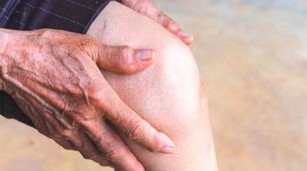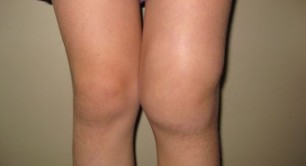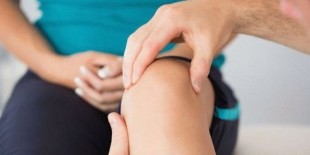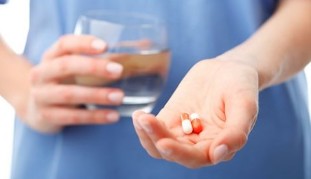Osteoarthritis of the knee (gonarthrosis) is a disease characterized by degenerative-dystrophic changes in cartilage, menisci, and then the bones forming the knee joint. The disease takes a leading place among the pathologies of the locomotor apparatus.

Causes of osteoarthritis
Osteoarthritis of the knee is a polyetiological disease, that is in this state when the development of pathological changes contribute to several causal factors. In this case we speak of primary (idiopathic) osteoarthritis. In secondary osteoarthritis is the exact factor that caused the disease.
The main causes of osteoarthritis include:
- a knee injury;
- surgical intervention in the knee region;
- increased physical load;
- overweight, obesity;
- congenital abnormality of the lower extremities;
- the syndrome of systemic connective tissue dysplasia;
- the metabolic disorders;
- common disease (diabetes, rheumatoid arthritis, acromegaly).
Important!
The impact of traumatic agent is the main cause of osteoarthritis in young age. Injuries of the knee, leading to osteoarthritis include sprains, fractures or any damage to the meniscus.
The basis for the development of pathological changes is the need of mobilization of the joint after an injury, it can cause poor blood circulation in periarticular tissues, which in conjunction with the existing mechanical damage leads to delayed healing and the development of symptoms of osteoarthritis.
Increased physical activity is manifested not only in the intense physical exercises, but in the presence of excess weight. Overweight and exercise, not suitable for every age and level of physical fitness of a person, lead to the appearance of cracks in the cartilage or menisci, is the first link in the process of formation of osteoarthritis.
Congenital abnormality of the lower extremities, which includes shortening one of the limbs, dysplasia, and valgus or varus deformity of the feet leads to arthritis due to uneven distribution of body weight. As a result, the dividing cartilage is formed a hearth of aseptic inflammation with the appearance of the characteristic clinical symptoms of osteoarthritis.
The syndrome of systemic connective tissue dysplasia characterized by Hyper-mobility and insufficiency of the ligamentous apparatus. Resulting in increased joint range of motion, up to the pathological. This imbalance quickly leads to the emergence of microtrauma to the menisci and articular surfaces of cartilage.
Violation of metabolism and the presence of General somatic pathology provokes the development of osteoarthritis due to the disturbance of microcirculation in the knee joint, the nutrition of the cartilage and menisci, the deterioration of the composition of the synovial fluid.
Classification
Code according to ICD 10 – M17. Depending on the etiological factor that contributes to the formation of osteoarthritis, there are the following categories:
- M17.0 primary gonarthrosis, bilateral;
- M17.1 – other primary gonarthrosis;
- M17.2 post – traumatic gonarthrosis, bilateral;
- M17.3 other post-traumatic gonarthrosis;
- M17.4 other secondary gonarthrosis, bilateral;
- M17.5 other secondary gonarthrosis;
- M17.9 gonarthrosis unspecified.

There are the following types of knee arthritis:
- involution arises as a consequence of age-related changes of the body, the metabolic process of the wear of the articular surfaces of the bones;
- dysplastic associated with congenital anomalies of the lower extremities;
- post traumatic;
- metabolic – occurs when common diseases involving metabolic disorders (gout, chondrocalcinosis);
- dishormonal, occurs when hormonal imbalance in the body in diabetes, menopause, disorders of the thyroid gland;
- after-fiery – arises after infectious-inflammatory diseases of the knee joint;
- static – manifests itself in excessive physical activities, improper distribution of weight, obesity;
- ischemia – is associated with impaired blood supply to the knee region.
Pathogenesis
The disease develops gradually. First changes appear in Podhradie layer microcracks. The appearance of micro-cracks triggered by the ongoing work of the knee joint, one of whose functions is attenuation of the shock when walking. And in the presence of etiological factors, the load on the knee increases even more, and the processes of destruction begin to exceed the recovery processes of the cartilage tissue, resulting in cracks.
Subsequently penetrates into cracks synovial fluid, and form cysts that have a tendency to increase and the merger. Large cysts begin to compress the blood vessels that feed the cartilage, leading to oxygen starvation of the cartilage tissue. Violated the metabolic processes, deteriorating the synthesis of collagen necessary for rebuilding cartilage. Given the poor recovery of the cartilage, there is a gradual thinning that leads to dysfunction of the joint, appear the clinical signs of the disease.
Note!
With the progression begin to form osteophytes – bony growths. Osteophytes are predominantly located on the edges of the articular surfaces of bones. Their presence provokes pronounced inflammatory reaction in the joint, pain, joint deformity, significant limitation of mobility.
In the development of inflammation there is swelling of the tissues, which leads to increased pressure in the joint, deterioration of the composition of the synovial fluid, disturbed nutrition of the cartilage.
Clinical symptoms
In the course of the disease there are several degrees of osteoarthritis, which reflect the process of progression of pathological changes and have certain clinical manifestations.
The symptoms of osteoarthritis of the knee joint can be divided into stages:
- The initial stage of the disease characterized by the appearance of painful sensations in the knee region, especially after intense physical exercise or prolonged standing up. Less favorable static load, ie lifting weights. Pain in the joint spontaneously after rest. In addition to pain, you may receive a crunching or clicking in the joint, which indicates the violation of the congruence of the articular surfaces of the bones forming the joint, and the appearance of cracks in the cartilage. The absence of pronounced clinical signs leads to the fact that most patients do not seek medical help in the initial stage, leading to late diagnosis.
- The progression of the disease leads to the formation of more pronounced pain syndrome, pain occurs even after a light load, can't pass. Appears morning stiffness in the joint lasting about 30 minutes, but if you join the inflammation, the stiffness can last up to 1 hour. Due to the severe pain a person begins to spare the leg, reduced range of motion, lameness appears. Due to swelling of the tissues of the knee increases in volume. Appear radiological signs of arthrosis of the knee joint.
- The appearance of osteophytes describes the development of 3 stage of disease in which severe pain, even at rest, poorly jugulate medicines. Movements are virtually absent, the joint is deformed. Possible jamming of the knee in a certain position and dislocations or subluxations.

Diagnostic testing
Diagnosis of osteoarthritis consists of several components:
- Patient's complaints.
- The history of the development of the disease.
- Life history of the patient.
- Laboratory and instrumental methods of research.
On the basis of complaints of patient and anamnesis of life and disease, the doctor puts the preliminary diagnosis. But for the differential diagnosis with other pathologies and accurate diagnosis is necessary to conduct laboratory and instrumental methods.
To instrumental examination of the knee joint include:
- radiography;
- arthroscopy;
- computed tomography;
- an ultrasound examination;
- magnetic resonance imaging.
Important!
The main method of diagnosing osteoarthritis is x-ray examination. X-ray of the knee done in two projections, giving a complete picture about your current changes. It is important to note that at the initial stages of osteoarthritis in the photo is not shown.
On the basis of the detected radiological signs is based radiological classification of osteoarthritis:
- 1 degree – slight narrowing of the joint space;
- Stage 2 – slight narrowing of the joint space, the presence of bone seal;
- 3 degree – severe narrowing of the joint space, presence of osteophytes, signs of bone deformation;
- 4 degree – marked narrowing of the joint space up to its complete absence, numerous osteophytes, destruction of bone, deformity of the joint.
Other methods of examination of the knee is an addition to the main x-ray tests. And held as additional diagnostic difficulty in diagnosis.
Each of the diagnostic techniques has its own indications, contraindications and various cost, therefore must be prescribed by a specialist if necessary.
How to treat osteoarthritis of the knee
Treatment of knee arthritis should begin with the appearance of the first clinical symptoms of the disease. Modern treatment of osteoarthritis of the knee is aimed at the restoration of joint function and improving the quality of life of patients and is the following:
- termination or reduction of pain;
- the treatment of the inflammatory process;
- the repair of the cartilage matrix;
- increase range of motion;
- improvement of microcirculation in the periarticular tissues.

Note! It is important to note that at different stages different methods of treatment. If the time to begin to deal with the illness, you can not only get rid of pain and restore the knee joint arthrosis, and to prevent the occurrence of complications.
Dosage therapy helps to reduce pain and inflammation, this is achieved by the use of nonsteroidal anti-inflammatory drugs. To restore the cartilage assigned to a chondroprotector. The scheme of treatment prescribed and monitored by a medical professional.
In addition to medication are appointed by physiotherapy, ointments, gymnastics, massage or intra-articular injections of drugs.
Than to treat osteoarthritis of the knee
In this case, the admission of gelatin, which can be taken inside or make a compress. Traditional medicine should not be administered as monotherapy and to be a part of the complex of therapeutic measures. Before you start this treatment at home, you should be familiar with recommendations and reviews.
Is there a cure for arthritis
Improper or delayed treatment, the consequences of disease progression are not forced to wait. Gonarthrosis is dangerous because even proper treatment can not completely stop the process, only slow it, but it allows a person a longer time to stay active.
If the disease has reached a severe stage, then conservative treatment becomes ineffective. In stage 3, surgical treatment, after which the long-term rehabilitation.




























